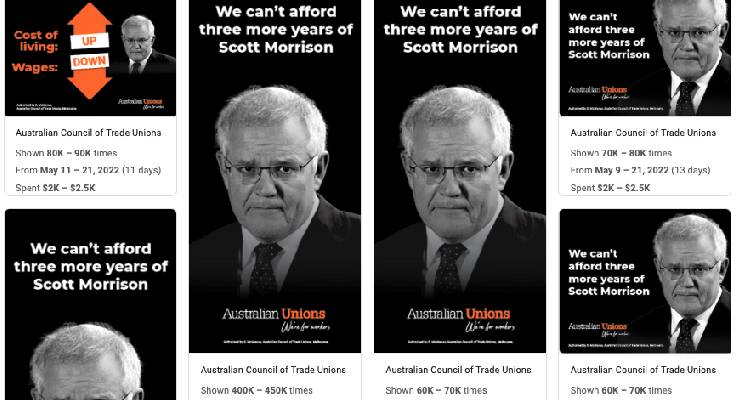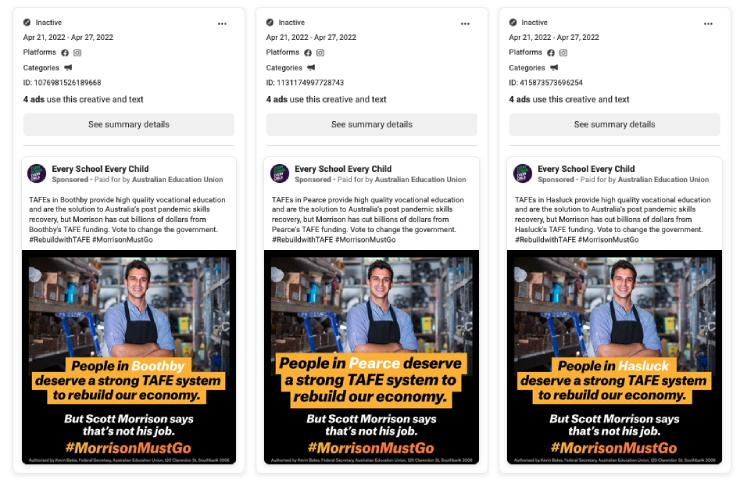
Unions were a major force online during last month’s election, pouring hundreds of thousands of dollars into digital advertising attacking the Coalition government and creating popular social media content.
Unions were among the biggest non-political parties spending on online advertising during the six-week campaign. More than a dozen spent at least $10,000 on advertising on Facebook, Instagram or YouTube over that time, with a handful spending more than $100,000.
The Australian Council of Trade Unions (ACTU) was the biggest spender, outlaying about $400,000 which was split evenly between Facebook and YouTube. It used a combination of video and image ads to attack Scott Morrison over low wage growth and high cost of living. These ads, focused on NSW, Victoria and Queensland, were seen more than 20 million times across both platforms during the last four weeks of the campaign.
Other campaigns were more issue-specific. The Australian Education Union (AEU) ran a targeted campaign about public school funding called “Every School Every Child”. It spent up to $220,000 showing 183 different ads to more than 11 million on Facebook and Instagram. Custom ads were created for specific electorates.

Unions were also behind the online advertising campaigns of some Labor candidates. On top of running a specific aged care campaign, the United Workers Union was also responsible for the Facebook ads for candidates in Boothby, Brisbane, Flynn, Chisholm, Dawson and Pearce — each of whom spent somewhere between $5000 and $20,000.
Beyond paid advertising, unions were also some of the the loudest voices in organic, non-paid election content on social media. ACTU’s Sally McManus’ Facebook posts reached large numbers of people; her page received more reactions and six times as many shares as former deputy Liberal leader and treasurer Josh Frydenberg during the election period, according to social media analysis tool CrowdTangle.
The Australian Unions’ Facebook page, run by the ACTU, had more Facebook engagements than the Australian Greens. They were also active on other social media platforms, such as TikTok, where they targeted younger voters with anti-government messages — sometimes failing to include proper electoral authorisation.
One creative campaign was a Unions NSW commercial partnership with popular meme account Brown Cardigan that involved designing an anti-Morrison mobile billboard. Videos of the billboard being driven around Sydney were posted to Unions NSW and Brown Cardigan’s social media accounts. (The Brown Cardigan’s posts didn’t feature an authorisation; Unions NSW said it had abided by all authorisation requirements.)
Splashy campaigns run by lobby groups like Advance Australia got a lot of attention but it was unions who made some of the biggest waves online during the election campaign.








More seriously unions need to take advantage of the times to encourage and ensure increased union coverage (halved in past generation), membership and award compliance, in addition to accessing non unionised workers and/or non traditional workplaces.
They may have poured hundreds of thousands into the campaign, but t’s still a pittance in comparison to what was spent by Clive Palmer.
I think that unions need to get more involved in the lives of the members or those who they would like to attain membership for. They should seriously think about junking Labor if they won’t make reforms favourable to them. I await my unions call with interest. Many will think it job well done and go home for 3 years not realising that unions were strongest when the conservatives were in during the 50s and 60s. It was they who demolished Fraser more than Labor under poor old Bill Hayden during the late 70s and early 80s.